PEMS 25th Annual Convention
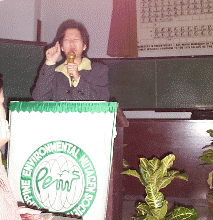 PEMS held its 25th Annual Convention last November 26, 2005 at the Institute of Chemistry, College of Science,
University of the Philippines at Diliman, Quezon City. The theme of the convention was "Detecting Mutations".
Inspiring talks from well-known researchers working in the field of mutation from the National Institute of Molecular
Biology and Biotechnology and the Institute of Biological Sciences, University of the Philippines, Diliman and Los Baños,
respectively, highlighted the event. Dr. Rita P. Laude delivered a talk on mutation at the morphological, biochemical,
molecular level and Dr. Cynthia P. Saloma delved on the different animal models used in studying mutation.
Three different workshops in the afternoon was also conducted and facilitated by Dr. James A. Villanueva of the Institute
of Chemistry (Mutation Assays), Dr Sonia D. Jacinto of the Institute of Biology (Anticancer Assays), Dr. Virginia D. Monje
and Dr. Ameurfina D. Santos of the National Institute of Molecular Biology and Biotechnology (DNA Analysis).
PEMS held its 25th Annual Convention last November 26, 2005 at the Institute of Chemistry, College of Science,
University of the Philippines at Diliman, Quezon City. The theme of the convention was "Detecting Mutations".
Inspiring talks from well-known researchers working in the field of mutation from the National Institute of Molecular
Biology and Biotechnology and the Institute of Biological Sciences, University of the Philippines, Diliman and Los Baños,
respectively, highlighted the event. Dr. Rita P. Laude delivered a talk on mutation at the morphological, biochemical,
molecular level and Dr. Cynthia P. Saloma delved on the different animal models used in studying mutation.
Three different workshops in the afternoon was also conducted and facilitated by Dr. James A. Villanueva of the Institute
of Chemistry (Mutation Assays), Dr Sonia D. Jacinto of the Institute of Biology (Anticancer Assays), Dr. Virginia D. Monje
and Dr. Ameurfina D. Santos of the National Institute of Molecular Biology and Biotechnology (DNA Analysis).
The convention was a success evidenced by the attendance of 165 participants from various schools and industries, namely:
UP Diliman (UPD), UP Baguio (UPB), UP Manila (UPM), University of Santo Tomas (UST), Tarlac State University (TSU),
Pamantasan ng Lungsod ng Pasig (PLP), Pamantasan ng Lungsod ng Maynila (PLM), Pampanga Agricultural College (PAC), Holy Angel
University (HAU), San Roque National High School (SRNHS), La Paz National High School (LPNHS), Franscisco G. Nepomuceno Memorial
High School (FGNMHS), Dee Hwa Liong College Fooundation (DHLCF), Philippine Nuclear Research Institute (PNRI), and Asian
Development Bank (ADB).
Cash prizes amounting to four thousand pesos (P 4,000.00) were given away to lucky participants who were able to answer
the questions based on the plenary lectures and poster presentations in the quiz portion of the convention.
T-shirts were also given to participants who came from the farthest locality.
The workshops in the afternoon were on the following:
In Vitro Assays to Detect Anticancer Substances
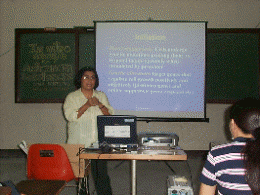 Natural or man-made products suspected to have anticancer property could be assayed for potential as chemopreventive and/or chemotherapeutic agents.
Cancer chemoprevention is defined as the use of drugs, vitamins, or other agents to try to reduce the risk of, or delay the development or recurrence of,
cancer. Chemotherapy is the treatment of cancer using specific chemical agents or drugs that are selectively destructive to malignant cells and tissues
(answers.com). Carcinogenesis is a multistage process that generally takes a long time. The stages include initiation, promotion and progression.
Chemoprevention can occur in any of these stages. Assays on chemoprevention that will be discussed here will include the following:
Natural or man-made products suspected to have anticancer property could be assayed for potential as chemopreventive and/or chemotherapeutic agents.
Cancer chemoprevention is defined as the use of drugs, vitamins, or other agents to try to reduce the risk of, or delay the development or recurrence of,
cancer. Chemotherapy is the treatment of cancer using specific chemical agents or drugs that are selectively destructive to malignant cells and tissues
(answers.com). Carcinogenesis is a multistage process that generally takes a long time. The stages include initiation, promotion and progression.
Chemoprevention can occur in any of these stages. Assays on chemoprevention that will be discussed here will include the following:
- determination of antioxidant property using DPPH
- determination of a product's ability to prevent cancer at the stage of promotion using a preinitiated JB6, a murine epidermal cell line
- assay which determines the ability of a substance to activate a Phase II enzyme, quinone reductase, which helps neutralize potential carcinogens in vivo.
Assays on chemotherapy will assess the property of a substance to kill cancer cells or cause their differentiation to the normal functioning phenotype.
This will include the following:
- cytotoxicity assay (using MTT) which determines the property of the product to kill cancer cells using human cancer cell lines
- cell differentiation assay using the promyeloid cell line HL-60 which monitors the ability of a product to induce the differentiation of immature
carcinogenic cells towards a mature normal and functional phenotype.
Since the nature of the assays require observation for at least a week and necessitate monitoring cell changes with an inverted microscope,
only the DPPH assay can be fully demonstrated and worked out here and to a certain extent, the cytotoxicity assay using MTT. All the other assays
will only be discussed during the introductory presentation.
Mutagenicity Assays
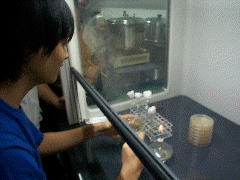 REC Assay. The Rec assay, developed by Kada et al, is used to determine the DNA-damaging capacity of samples.
It does not measure mutagenic events per se, but gives an indication of the interaction of a substance with DNA
implying genotoxicity. It measures the difference in chemically-induced cell killing between a strain with full repair
capacity and repair-deficient strain. This assay involves the use of bacteria Bacillus subtillis, whose cellular membrane
is more permeable to chemicals compared to other enteric bacteria. Two strains of B. subtillis are used, the
recombinant-proficient strain (H17, Rec+) and the recombinant-deficient strain (M45, Rec-). REC Assay. The Rec assay, developed by Kada et al, is used to determine the DNA-damaging capacity of samples.
It does not measure mutagenic events per se, but gives an indication of the interaction of a substance with DNA
implying genotoxicity. It measures the difference in chemically-induced cell killing between a strain with full repair
capacity and repair-deficient strain. This assay involves the use of bacteria Bacillus subtillis, whose cellular membrane
is more permeable to chemicals compared to other enteric bacteria. Two strains of B. subtillis are used, the
recombinant-proficient strain (H17, Rec+) and the recombinant-deficient strain (M45, Rec-).
Micronucleus Test. The Micronucleus test is an in vivo method devised primarily for screening chemicals for chromosome-breaking
effects. During mitosis, in the anaphase stage, acentric chromatid and chromosome fragments lag behind when the centric elements
move towards the spindle poles. After telophase, the undamaged chromosomes, as well as the centric fragments, give rise to
regular daughter nuclei. The lagging elements are included in the daughter cells too, but a considerable proportion is
transformed into one or several secondary nuclei that are smaller than the principal nucleus and are called micronuclei.
The micronuclei are found in a variety of bone marrow cells of animals tested with mutagens.
MolBio Pen and Paper Exercises

 Instead of a wet lab in Molecular Biology and Biotechnology (MBB), we have pen and paper exercises. With these
hands-on exercises, the participant will have a better appreciation of the central dogma of molecular biology
(or how a gene works), the correlation of gene mutation with health and disease, and DNA fingerprinting as a means
to establish identity and relationships.
Instead of a wet lab in Molecular Biology and Biotechnology (MBB), we have pen and paper exercises. With these
hands-on exercises, the participant will have a better appreciation of the central dogma of molecular biology
(or how a gene works), the correlation of gene mutation with health and disease, and DNA fingerprinting as a means
to establish identity and relationships.
PICTURES
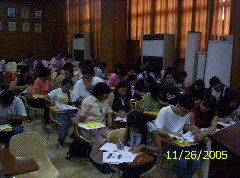
Participants of the MolBio Pen and Paper Exercises Workshop |

Rec Assay Viewing Station
|
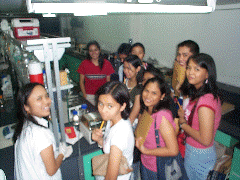
Participants in the Mutagenicity Assay Workshop
|
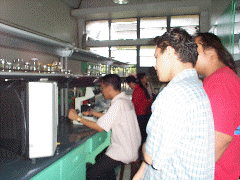
A participant viewing a micronucleated polychromatic erythrocyte (MNPCE) under the microscope in the Micronucleus Test (a Mutagenicity Assay) |

Dr. Titos A. O. Quibuyen presenting a token of appreciation to Prof Clara Y. Lim-Sylianco, founding President of PEMS
|
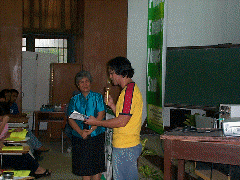
Dr. Titos A, O. Quibuyen presenting a plaque of appreciation to Dr. Rita P. Laude of UPLB IBS for delivering a lecture on mutation |
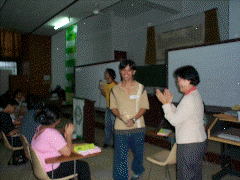
Dr. James A. Villanueva was given a plaque of appreciation for facilitating the Workshop on Mutagenicity Assays
|
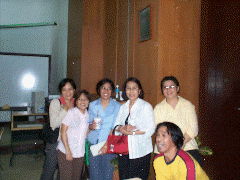
from left to right: Dr. Virginia D. Monje, Dr. Mafel C. Ysrael, Dr. Irene M. Villaseñor, Dr. Amelia P. Guevara,
Dr. Evangeline C. Amor and Dr. Titos A. O. Quibuyen (foreground) |
|

